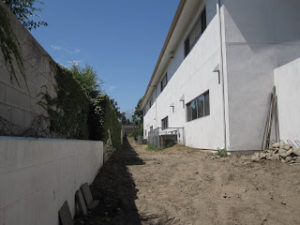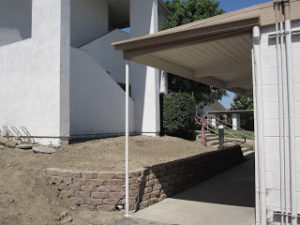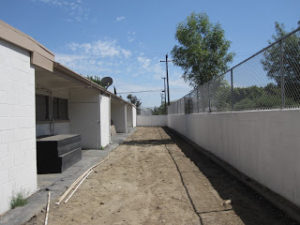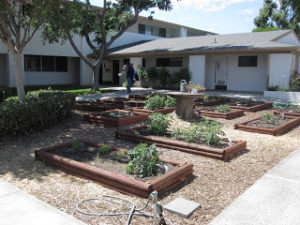The other day I met at Redeemer Lutheran with some of the volunteers on the project. We went over some of our plans for the garden, a small site analysis was done to find out what we can put where. Because of the location we found we have some restrictions due to sun exposure: than you to Tony Palmisano and Eleanor Torres’ solar exposure model. Their orchard type garden is going to be on the west side of 2 buildings with only about 15 feet to a block wall. The building on the north end is a two story building so it is going to block out a lot of sun, the block wall is also higher at about 9 feet.

The North section of the “Orchard”.
We thought some tall growing avocados may work well here so that they have an opportunity to reach for the sun. After some discussion we may actually go with some Fig trees instead. Figs are great for the region because they are a mediterranean fruit and we are in a mediterranean climate. Once they are established they will require no irrigation (Avocados don’t require much but their leaves may brown). Figs are water wise and climate appropriate. Fortunately figs are deciduous so it will allow some sun light to get through in the winter. Their extremely soft wood also makes pruning nearly effortless.

Between the North and South Buildings.
Between the two buildings we have an opportunity to place a row of espaliered citrus as suggested by Mary Petit who is well known for her involvement with community gardens in the area. By facing the espaliered trees towards the south they’ll be able to get enough sun, it may be possible to fit two rows close together and still be successful since the building to the south is at a lower elevation than where they trees would go just north of that. However that space may just be too small. I think it is worth a shot and while we may not get a lot of fruit off of the more shaded row, we may at least get some.

Southern orchard.
In the southern portion, between the one story building and the short block wall, we’ll be able to place about 15 various fruiting trees. We haven’t decided exactly what, but Tom Spellman of Dave Wilson Nursery has announced he’d be able to donate a good portion of those trees if not all of them.
Joe was able to show me where all the irrigation lines ran and where we could connect off of the old irrigation. This area already has its own valve, so we luckily won’t need to put in another valve. With the drip that we are going to use we can control the amount of water at each tree with the shrubbler emitters that we use.

Redeemer’s existing vegetable beds were just put in this spring.
Maleene also showed me a portion of their garden that they have already put together. They have vegetable beds that were just made and have already begun some plants. We’ll be supplying a short picket fence around the garden to help keep the vegetables from being trampled.
Right now I’m preparing their irrigation so that we can begin work with volunteers. Unfortunately, their soil has a LOT of rocks of all different sizes, it sometimes feels like I’m digging into gravel (which is not easy) sometimes I’ll hit a large rock and have to dig it out to move it out of the way. A lot of times soil type can make a job that can be done in one day with sandy-loam soil take 3 days with rocky or clay soils. The foothills are famous for their “potatoes” so we’ll see how it goes. Fortunately those “potatoes” can make great decorations!
